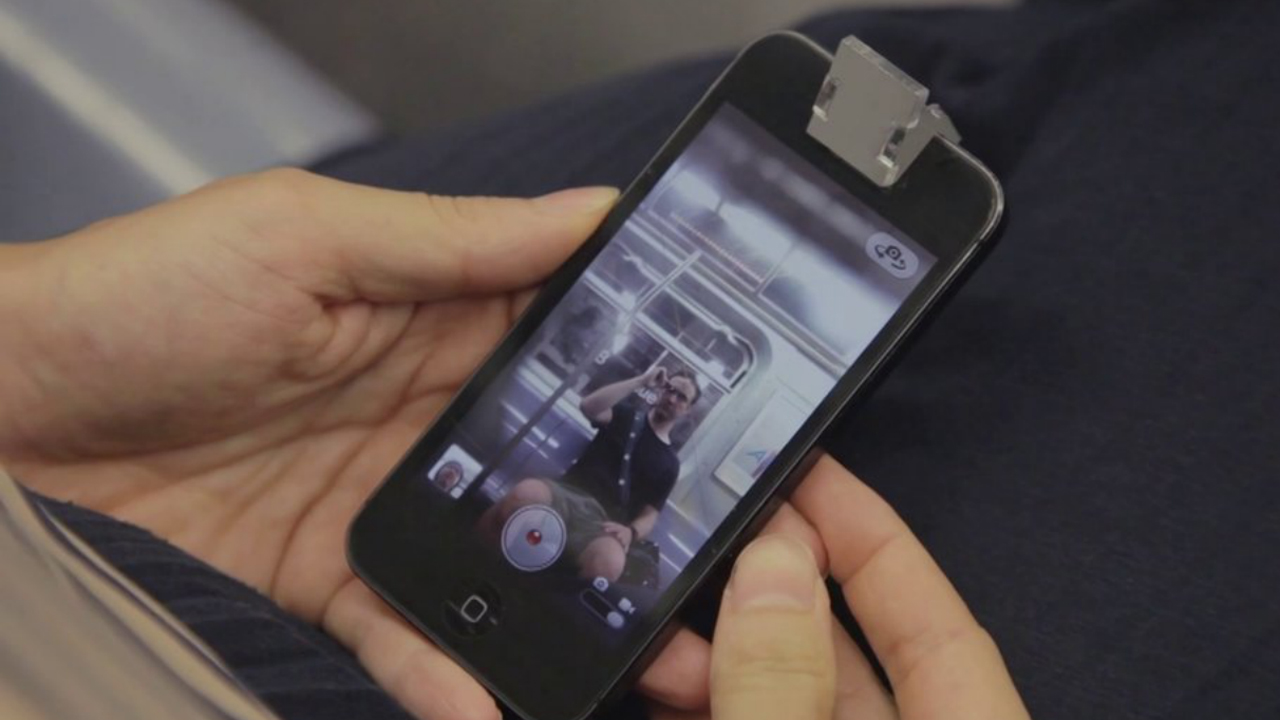“We have something for you. You’re going to like it.”
“What is it?… Oh? Oh!!! Uh oh.”
When new media artist James George and tech-savvy photographer Alexander Porter popped the tiny appendage on my iPhone a few months ago for a test drive, I knew I was going to have too much fun with it. The #slyPhone is a single-mirror laser cut periscope that “redirects your iPhone’s camera 90° so you can take pictures without drawing attention.”

Just think of the possibilities… Discretely record police brutality! Vine jerks on the subway without rousing suspicion! Give your street photography an edge! Capture your friends’ attempts at wooing a potential sexual partners without interrupting! (Sorry about that.) But seriously, don’t be an asshole. Have fun. The #slyPhone laser-cutter files are available for free download. A special Black Mirror Edition is available for sale at Minor Asset, as of today.
You may remember the #slyPhone creators George and Porter for their RGBDToolkit — a hacked DSLR camera and Kinect depth sensor system — which they used to make their new media CLOUDS documentary with Jonathan Minard, which is, like slyPhone, freely available, via open-source, to make music videos and art porn with. ANIMAL talked to the #slyPhone creators George and Porter about its origins, its heroic, villainous and creative potential and “sousveillance – the act of bottom-up or inverse surveillance.” Read on to find out how to score a free one. Don’t be a creep.
Public photography is something that is on a lot of people’s mind right now. Between the rise of the Google Glasshole and NSA whistleblowers on the lam, it is easy to feel powerless and threatened in our surveillance society. But simple hacks can tip the scales without the need for sci-fi hi-tech. The slyPhone is a social hack that relies on disguising the overt photographic gesture of raising your phone to use your front-facing camera. It let’s you slyly capture the curious, weird, beautiful or threatening things in your surroundings without drawing attention.
What inspired you to do this project?
In researching Google Glass we discovered the work of Steve Mann, a researcher in the field of wearable computing and photography who has been developing a strikingly similar technology that predates Glass by around three decades. He has very interesting ideas on the topic of surveillance and introduced us to the concept of sousveillance – the act of bottom-up or inverse surveillance.
We’d been passing out slyPhones to friends and keeping a shared server of our our sly-photo collection and were struck by the amazing range of conversations that it generated. We became inspired to put a modern twist on the desire to photograph in public with inspiration from Walker Evans, Garry Winogrand, Robert Frank or more recently as we discover, Vivian Maier. We are selectively releasing images we’re gathering and taking through the @sly_phone twitter account. As we are now making the project public, we’ll be tracking the all the images people take through the #slyphone twitter stream. We’re very curious to see where it goes.
How can we get one?
We’re doing a parody of the Google Glass Explorers program. If you post a tweet starting with #isly how you would use it we’ll send you one in the mail. We’re also going to be anonymously distributing them in public places and watching how people react to them.
How easy is it to make one yourself?
The plans we released require a laser cutter, something that few people own but are easy to find at local hack spaces and universities. But it’s just a slanted mirror, so it’s easy to imagine making one yourself. For example artist Aram Bartholl made a similar hack back in 2009, and there is even this product for it. Our point with slyPhone is less about the device and more about pointing the finger at the social situation that arises when this possibility is available.
What is the perfect use for this?
We are hoping to be surprised! The perfect use is in the eye of the beholder and we’re hoping that by letting the crowd explore the possible outcomes we can broaden the discussion about the ways that public photography is changing. There has been so much discussion about images captured without consent in public by companies and governments and we wanted to involve the public and the human impulse to photograph in that discussion. There’s no better way than being really close to another human being and taking their photograph to investigate the current state of the photographic impulse.
 What are you hoping people won’t do with this?
What are you hoping people won’t do with this?
Public photography often has a sinister side, which we may well be enabling with slyPhone. In particular we’ve come across the voyeurist trend of ‘creepshots’, that is sexualizing photos taken largely of women in public space without their knowledge, then swapped in online on channels like r/creepshots. They claim freedom of expression as a protection very sketchy behavior though seemingly in some cases time seems to forgive them. For example Czech photographer Miroslav Tichý created many images with homemade cameras that are undeniably embedded with lust and voyeurism that seem to have been publicly redeemed through time and artistry.
So far we have seen men taking creepy pictures of women, women doing the same of men, photos of people inputting their ATM pin numbers and a lot of sweet and pensive photos of people on public transit. We want to explore the full range of uses: from pranks, to sousveillance, from voyeurism to observational art photos. In order to do that we can’t be too choosy. We’re finding that there is something really poignant, interesting and very often strange about human curiosity unleashed.

(Photos: #SlyPhone, Miroslav Tichý)




